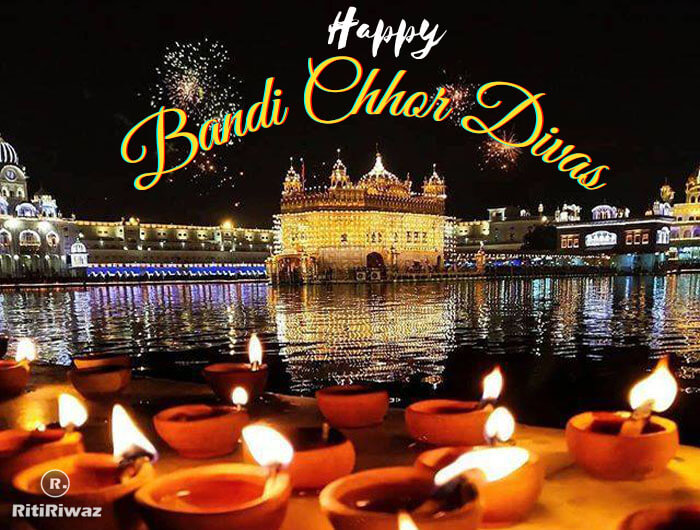Bandi Chhor Divas – The Day of Liberation

Bandi Chhor Divas is a Sikh tradition of Diwali and the second most important day after the Vaisakhi festival in April. The festival of Diwali is celebrated all over India to signify Lord Rama’s return home from 14 years in exile after destroying the demon god Ravana. While the Sikhs celebrate their struggle for freedom from the oppressive Mughal regime.
Bandi Chhor Divas, Day of Freedom or the Prisoner Release Day will fall on Monday 24 October 2022.
Etymology
The word “Bandi” means “imprisoned“, “Chhor” means “release” and “Divas” means “day” and together “Bandi Chhor Divas” means Prisoner Release Day. It is celebrated with great joy as it was a time when “right” prevailed over “wrong”
History
The festival of Bandi Chhor Divas takes place to remember that Guru Hargobind (the sixth Guru) was released from prison in AD 1619. Sikhs believe that Guru Hargobind freed 52 kings with him that day and this freedom is celebrated with feasts, fireworks, and the lighting of candles and lamps. It is also believed that the foundation stone of the Golden Temple was laid during the time of Diwali in 1577.
According to many scholars of Sikhism and Sikh history, Diwali in the Sikh tradition is older than the sixth Guru Hargobind legend. Guru Amar Das, the third Guru of the Sikhs, built a well in Goindwal with eighty-four steps and invited Sikhs to bathe in its sacred waters on Baisakhi and Diwali as a form of community bonding.
It is believed that the sixth Guru, along with 52 Hindu Rajas (Kings), was being held as a political prisoner by the Mughal Emperor Jahangir in October 1619, despite being otherwise innocent of any crimes. The Emperor was under pressure from influential moderate Muslim religious leaders like Hazrat Mian Mir, a friend of the Guru to release Guru Hargobind.
Jahangir met with the Guru during his imprisonment and became close to him partly because the Guru saved him from a lion whilst out hunting, but also because the Guru’s prayers were thought to have cured the Emperor of a serious illness. Such was the debt, the Emperor felt he owed Guru Hargobind. He agreed to release him on Diwali but the Guru refused to accept his release unless he could take the other 52 Rajas with him.
Jahangir relented grudgingly and ordained, Let those rajahs be freed who can hold on to the Guru’s coattails and walk out of prison. He had in mind no more than four or five being freed with the Guru. However, the Guru was not to be outmaneuvered in this way and arranged for a special coat to be made with 52 coattails – the same number as the rajahs in prison with him. And so the rajahs were freed and the Guru became known popularly as the Bandi Chhor.
He arrived at Amritsar on the day of Diwali and the Sri Harr-Mandar Sahib (also known as the Golden Temple) was lit with thousands of lamps. Guru Hargobind was received in the same way Lord Ram was received when he returned to his kingdom. Giving further homage to the festival which celebrates the triumph of Right over Wrong.
Celebration
During October/November, the worldwide Sikh Sangat (community) celebrates the safe return of the sixth Nanak, Guru Hargobind. Many families and friends marking this occasion decorate homes, light diyas, share meals, and exchange gifts. Bandi Chhor Divas is a time of celebration, where family and friends traditionally gather to read the Sikh holy book – the Guru Granth Sahib – feast, and adorn their homes and Gurdwaras in colorful lights.
Many choose to make a pilgrimage to the Golden Temple which is the most important pilgrimage site in the religion. On this day, the Golden Temple in Amritsar is also illuminated with Diyas and celebrated with the lighting of fireworks. It is an important Sikh celebration along with Vaisakhi, Maghi, and Holi with Hola Mohalla and Gurpurb.
Hey Waheguru! “Raaj Na Chaahayu, Mukti Na Chaahyu Man Preet Charan Kamlaare”
Oh Wonderful Lord! I neither desire for empire and material realm nor liberation or mukti, my soul longs for the love of your lotus feet.
Celebrating Diwali and Lightening a Diya in the true sense is acquiring divine knowledge and being selfless, tolerant, humble, kind, and sweet-spoken. That leads one to become one with Waheguru (god).






